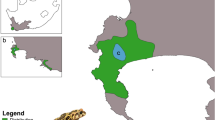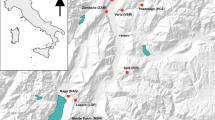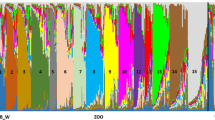Abstract
The effects of population bottlenecks, from both the population and conservation genetics point of view, have attracted great interest. Heterozygosity and allelic diversity are basic components of the evolutionary potential of populations. Many endangered species go through bottlenecks from time to time. The consequences are important because in the resulting small populations the stochastic processes are more pronounced and, by strengthening each other, they can lead to extinction. Within the framework of the global climate change the question emerges of how the different species, primarily susceptible ones and those depending on protection measures, react to the climate extremities. It is well known that a large proportion of Barn Owl Tyto alba populations die following an unfavourable period. In the study reported here we genotyped 24 microsatellite loci of 58 unrelated Barn Owl individuals originating from a continuous population of three neighbouring Hungarian counties. We then performed the Wilcoxon sign-rank test, the L test and Monte Carlo simulation of the loss of alleles and heterozygosity. We also attempted to infer past population dynamics using two likelihood-based Bayesian methods. Although a 74% reduction of this population is well documented following the harsh winter of 2002/2003 and the sampling and resolution of the methods used are standard and considered to be commonly satisfactory, none of the tests showed pronounced signs of a recent bottleneck. These results are discussed in terms of the imminent and apparent drawbacks of the models and methods used, the roles of absolute numbers of survivors versus genotype percentages and the conservation biological viewpoint.
Zusammenfassung
Demografische Verluste und Nachweis eines genetischen Flaschenhalses in einer Population von Schleiereulen Tyto alba in Ungarn
Sowohl vom populationsgenetischen Standpunkt als auch von dem der Artenschutzgenetik aus ist die Untersuchung von Flaschenhalseffekten von großem Interesse. Heterozygotie und Alleldiversität sind grundlegende Bestandteile des evolutionären Potenzials von Populationen. Viele gefährdete Arten durchlaufen von Zeit zu Zeit einen Flaschenhals. Die Folgen sind von Bedeutung, da in den daraus resultierenden kleinen Populationen stochastische Prozesse stärkeres Gewicht haben und durch sich gegenseitiges Verstärken zum Aussterben führen können. Im Hinblick auf den globalen Klimawandel stellt sich die Frage, wie verschiedene Arten, speziell die sensiblen und solche, die von Schutzmaßnahmen abhängig sind, auf klimatische Extreme reagieren. Von Schleiereulen ist allgemein bekannt, dass nach einer Phase schlechter Bedingungen ein großer Teil der Population stirbt. 58 nicht verwandte Individuen dieser Art aus einer zusammenhängenden Population in drei benachbarten ungarischen Kreisen wurden für 24 Mikrosatelliten-Loci genotypisch charakterisiert. Wir führten einen „Wilcoxon-Vorzeichen-Rang-Test“ und einen L Test sowie eine Monte Carlo-Simulation für den Verlust von Allelen und Heterozygotie durch. Mittels zweier wahrscheinlichkeitsbasierter Bayes-Methoden versuchten wir zudem, Rückschlüsse auf die vergangene Populationsdynamik zu ziehen. Obwohl Populationsverluste von 74% im Winter von 2002/2003 gut dokumentiert sind und die Probennahme sowie die Auflösung der verwendeten Methoden zum gängigen Standard gehören und gemeinhin als zufriedenstellend gelten, zeigte keiner der Tests deutliche Hinweise auf einen kürzlich durchlaufenen Flaschenhals. Wir diskutieren die immanenten und scheinbaren Nachteile der verwendeten Modelle und Methoden, die jeweilige Rolle der absoluten Überlebendenzahlen im Unterschied zu Genotyp-Prozentanteilen sowie den Artenschutzaspekt der Ergebnisse.





Similar content being viewed by others
References
Allendorf FW, Luikart G (2007) Conservation and the genetics of populations. Blackwell, Oxford
Altwegg R, Roulin A, Kestenholz M, Jenni L (2003) Variation and covariation in survival, dispersal, and population size in Barn Owls Tyto alba. J Anim Ecol 72:391–399
Altwegg R, Roulin A, Kestenholz M, Jenni L (2006) Demographic effects of extreme winter weather in the barn owl. Oecologia 149:44–51
Bartholy J, Pongrácz R, Gelybó Gy (2007a) Regional climate change expected in Hungary for 2071–2100. Appl Ecol Environ Res 5:1–17
Bartholy J, Pongrácz R, Gelybó Gy, Szabó P (2007) Expected change of temperature extremes in the Carpathian basin by the end of the 21st century. Klíma-21 51:3–17 (in Hungarian)
Beaumont MA (1999) Detecting population expansion and decline using microsatellites. Genetics 153:2013–2029
Burri R, Antoniazza S, Siverio F, Klein Á, Roulin A, Fumagalli L (2008) Isolation and characterization of 21 microsatellite markers in the Barn Owl (Tyto alba). Mol Ecol Resour 8(5):977–979
Burri R, Antoniazza S, Gaigher A, Ducrest A-L, Simon C, The European Barn Owl Network, Fumagalli L, Goudet J, Roulin A (2016) The genetic basis of color-related local adaptation in a ring-like colonization around the Mediterranean. Evolution 70:140–153. doi:10.1111/evo.12824
Bush JD, Waser PM, DeWoody JA (2007) Recent demographic bottlenecks are not accompanied by a genetic signature in banner-tailed kangaroo rats (Dipodomys spectabilis). Mol Ecol 16:2450–2462
Chan YL, Anderson CNK, Hadly EA (2006) Bayesian estimation of the timing and severity of a population bottleneck from ancient DNA. PLoS Genet 2:451–460
Cornuet JM, Luikart G (1996) Description and power analysis of two tests for detecting recent population bottlenecks from allele frequency data. Genetics 144:2001–2014
Dawson DA, Burke TA, Hansson B, Pandhal J, Hale MC, Hinten GN, Slate J (2006) A predicted microsatellite map of the passerine genome based on chicken-passerine sequence homology. Mol Ecol 15:1299–1320
England PR, Osler GHR (2001) GENELOSS: a computer program for simulating the effects of population bottlenecks on genetic diversity. Mol Ecol Notes 1:111–113
England PR, Osler GHR, Woodworth LM, Montgomery ME, Briscoe DA, Frankham R (2003) Effects of intense versus diffuse population bottlenecks on microsatellite genetic diversity and evolutionary potential. Conserv Genet 4:595–604
Frankham R, Ballou JD, Briscoe DA (2002) Introduction to conservation genetics. Cambridge University Press, Cambridge
Fuerst PA, Maruyama T (1986) Considerations on the conservation of alleles and of genic heterozygosity in small managed populations. Zoobiology 5:171–179
Garza JC, Williamson EG (2001) Detecing of reduction in population size using data from microsatellite loci. Mol Ecol 10:305–318
Gelman A, Hill J (2007) Data analysis using regression and multilevel/hierarchical models. Cambridge University Press, New York
Gelman A, Rubin DB (1992) Inference from iterative simulation using multiple sequences. Stat Sci 7(4):457–472
Griffiths R, Double MC, Orr K, Dawson RJG (1998) A DNA test to sex most birds. Mol Ecol 7:1071–1075
Groombridge JJ, Jones CG, Bruford MW, Nichols RA (2000) ‘Ghost’ alleles of the Mauritius kestrel. Nature 403:616
Hoelzel AR, Halley J, O’Brien SJ, Campagna C, Arnbom T, Le Boef B, Ralls K, Dover GA (1993) Elephant seal genetic variation and the use of simulation models to investigate historical population genetics. J Hered 84:443–449
Hsu Y, Severinghaus LL, Lin Y, Li S (2003) Isolation and characterization of microsatellite DNA markers from the Lanyu Scops owl (Otus elegans botelensis). Mol Ecol Notes 3:595–597
Hsu Y, Li S, Lin Y, Severinghaus LL (2006) Microsatellite loci from Lanyu Scops owl (Otus elegans botelensis) and their cross-species application in four species of Strigidae. Conserv Genet 7:161–165
Isaksson M, Tegelstroem H (2002) Characterisation of polymorphic microsatellite markers in a captive population of eagle owl (Bubo bubo) used for supportive breeding. Mol Ecol Notes 2:91–93
Klein Á, Horsburgh GJ, Küpper C, Major A, Lee PLM, Hoffmann G, Mátics R, Dawson DA (2009) Microsatellite markers characterized in the barn owl (Tyto alba) and of high utility in other owls (Strigiformes, AVES). Mol Ecol Res 9:1512–1519
Koopman ME, Schable NA, Glenn TC (2004) Development and optimization of microsatellite DNA primers for boreal owls (Aegolius funereus). Mol Ecol Notes 4:376–378
Korfanta NM, Schable NA, Glenn TC (2002) Isolation and characterization of microsatellite DNA primers in Burrowing owl (Athene cunicularia). Mol Ecol Notes 2:584–585
Küpper C, Horsburgh GJ, Dawson DA, Ffrench-Constant R, Szekely T, Burke T (2007) Characterization of 36 polymorphic microsatellite loci in the Kentish plover (Charadrius alexandrinus) including two sex-linked loci and their amplification in four other Charadrius species. Mol Ecol Notes 7:35–39
Küpper C, Burke T, Szekely T, Dawson DA (2008) Enhanced cross-species utility of conserved microsatellite markers in shorebirds. BMC Genomics 9(1):502. doi:10.1186/1471-2164-9-502
Lambert DM, King T, Shepherd LD, Livingston A, Anderson S, Craig JL (2005) Serial population bottlenecks and genetic variation: translocated populations of the New Zealand Saddleback (Philesturnus carunculatus rufusater). Conserv Genet 6:1–14
Lance SL, Maldonado JE, Bocetti CI, Pattee OH, Ballou JD, Fleischer RC (2003) Genetic variation in natural and translocated populations of the endangered Delmarva fox squirrel (Sciurus niger cinereus). Conserv Genet 4:707–718
Laroch J, Durand JD (2004) Genetic structure of fragmented populations of a threatened endemic period of the Rhone river: Zingel asper. Heredity 92:329–334
Lee PLM, Bradbury RB, Wilson JD, Flanagan NS, Richardson L, Perkins AJ, Krebs JR (2001) Microsatellite variation in the yellowhammer Emberiza citrinella: population structure of a declining farmland bird. Mol Ecol 10(7):1633–1644
Luikart G (1997) Usefulness of molecular markers for detecting population bottlenecks and monitoring genetic change. Mol Ecol 7(8):963–974
Luikart G, Allendorf FW, Cornuet JM, Sherwin WB (1998) Distortion of allele frequency distributions provides a test for recent population bottlenecks. J Hered 89:238–247
Marshall TC, Slate J, Kruuk LEB, Pemberton JM (1998) Statistical confidence for likelihood-based paternity inference in natural populations. Mol Ecol 7:639–655
Martínez JA, Zuberogoitia Í (2004) Habitat preferences and causes of population decline for Barn owls Tyto alba: a multi-scale approach. Ardeola 51:303–317
Mátics R (2003) Direction and movements in Hungarian Barn Owls (Tyto alba): gene flow and barriers. Divers Distrib 9(4):261–268
Mátics R, Bank L, Varga S, Klein Á, Hoffmann Gy (2008) Interspecific offspring killing in owls. Biol J Linn Soc 95:488–494
Menotti-Raymond M, O’Brien SJ (1993) Dating the genetic bottleneck of the African cheetah. Proc Natl Acad Sci USA 90:3172–3176
Mills LS, és Allendorf FW (1996) The one-migrant-per-generation rule in conservation and management. Conserv Biol 10(6):1509–1518
Nei M, Maruyama T, Chakraborty R (1975) The bottleneck effect and genetic variability in populations. Evolution 29:1–10
Newton I, Wyllie I, Asher A (2008) Mortality causes in British Barn Owls Tyto alba, with a discussion of aldrin–dieldrin poisoning. Ibis 133:162–169
Nicholls JA, Double MC, Rowell DM, Magrath RD (2000) The evolution of cooperative and pair breeding in thornbills Acanthiza (Pardalotidae). J Avian Biol 31:165–176
Nielsen ML, Dichmann K, Dahl CM et al (2014) Winter starvation in Danish Barn Owls. Dansk Orn Foren Tidsskr 108:164–170
O’Brien SJ (1994) Genetic and phylogenetic analyses of endangered species. Annu Rev Genet 28:467–489
Pecsenye K (2006) Populációgenetika. Pars Kft, Nagykovácsi
Peery MZ, Kirby R, Reid BN, Stoelting R, Doucet-Bëer E, Robinson S, Vásquez-Carrillo C, Pauli JN, Palsbøll PJ (2012) Reliability of genetic bottleneck tests for detecting recent population declines. Mol Ecol 21:3403–3418. doi:10.1111/j.1365-294X.2012.05635.x
Piry S, Luikart G, Cornuet JM (1999) Bottleneck: a computer program for detecting recent reductions in the effective size using allele frequency data. J Hered 90:502–503
Primmer CR, Møller AP, Ellegren H (1996) A wide-range survey of cross-species microsatellite amplification in birds. Mol Ecol 5:365–378
Proudfoot G, Honeycutt R, Douglas SR (2005) Development and characterization of microsatellite DNA primers for ferruginous pygmy-owls (Glaucidium brasilianum). Mol Ecol Notes 5:90–92
Raymond M, Rousset F (1995) Genepop (version 1.2) population genetics software for exact tests and ecumenism. J Hered 86:248–249
Redeker S, Andersen LW, Pertoldi C, Madsen AB, Jensen TS, Jørgensen JM (2006) Genetic structure, habitat fragmentation and bottlenecks in Danish bank voles (Clethrionomys glareolus). Mamm Biol 71(3):144–158
Reich DR, Feldman MW, Goldstein DB (1999) Statistical properties of two tests that use multilocus data sets to detect population expansions. Mol Biol Evol 16:453–466
Rew MB, Peery MZ, Beissinger SR, Berube M, Lozier JD, Rubidge EM, Palsbøll PJ (2002) Cloning and characterization of 29 tetranucleotide and two dinucleotide polymorphic microsatellite loci from the endangered marbled murrelet Brachyramphus marmoratus. Mol Ecol Notes 6:241–244
Rozen S, Skaletsky HJ (2000) Primer3 on the www for general users and for biologist programmers. In: Krawetz S, Misener S (eds) Bioinformatics methods and protocols: methods in molecular biology. Humana Press, Totowa, pp 365–386
Schwartz MK, Luikart G, és Waples RS (2007) Genetic monitoring as a promising tool for conservation and management. Tree 22(1):25–33
Slate J, Hale MC, Birkhead TR (2007) Simple sequence repeats in zebra finch (Taeniopygia guttata) expressed sequence tags: a new resource for evolutionary genetic studies of passerines. BMC Genomics 8:52
Spong G, Hellborg L (2002) A near-extinction event in lynx: do microsatellite data tell the tale? Conserv Ecol 6(1):15
Standovár T, Primack R (2001) A természetvédelmi biológia alapjai. Nemzeti Tankönyvkiadó Rt., Budapest
Storz JF, Beaumont MA (2002) Testing for genetic evidence of population expansion and contraction: an empirical analysis of microsatellite DNA variation using a hierarchical Bayesian model. Evolution 56:154–166
Sunnucks P (2000) Efficient genetic markers for population biology. Tree 15(5):199–203
Taylor I (1994) Barn Owls: predator–prey relationships and conservation. Cambridge University Press, Cambridge
Thode AB, Maltbie M, Hansen LA, Green LD, Longmire JL (2002) Microsatellite markers for the Mexican spotted owl (Strix occidentalis lucida). Mol Ecol Notes 2:446–448
Tingay RE, Dawson DA, Pandhal J, Clarke ML, David VA, Hailer F, Culver M (2007) Isolation of 22 new Haliaeetus microsatellite loci and their characterization in the critically endangered Madagascar fish-eagle (Haliaeetus vociferoides) and three other Haliaeetus eagle species. Mol Ecol Notes 7:711–715
van Treuren R, Bijlsma R, Tinbergen JM, Heg D, van de Zande L (1999) Genetic analysis of the population structure of socially organized oystercatchers (Haematopus ostralegus) using microsatellites. Mol Ecol 8:181–187
Voorrips RE (2002) MapChart: software for the graphical presentation of linkage maps and QTLs. J Hered 93(1):77–78
Waits L, Taberlet P, Swensson JE, Sandegren F, Franzén R (2000) Nuclear DNA microsatellite analysis of genetic diversity and gene flow in the Scandinavian brown bear (Ursus arctos). Mol Ecol 9(4):421–431
Williamson-Natesan EG (2005) Comparison of methods for detecting bottlenecks from microsatellite loci. Conserv Genet 6:551–562
Xia J, Zhenga J, Wang D (2005) Ex situ conservation status of an endangered Yangtze finless porpoise population (Neophocaena phocaenoides asiaeorientalis) as measured from microsatellites and mtDNA diversity. J Mar Sci 62(8):1711–1716
Acknowledgements
The study was partly financed by the Eötvös Scholarship for Á. Klein and by the Hungarian Nature Research Society (No. 1) and The Barn Owl Foundation (Bureau of Application in Higher Education No. FKFP0021/2002).
Author information
Authors and Affiliations
Corresponding author
Additional information
Communicated by M. Wink.
R. Mátics and G. Hoffmann contributed equally to the article.
Rights and permissions
About this article
Cite this article
Mátics, R., Hoffmann, G., Farkas, S. et al. Demographic decline and detection of genetic bottleneck in a population of Barn Owl Tyto alba in Hungary. J Ornithol 158, 811–821 (2017). https://doi.org/10.1007/s10336-017-1433-z
Received:
Revised:
Accepted:
Published:
Issue Date:
DOI: https://doi.org/10.1007/s10336-017-1433-z




